
Author: Natalie Ng|Updated: 6 May 2025
Tangled hair happens to everyone—especially if your hair is long, fine, naturally curly, or just had a rough night on a cotton pillowcase. Whether it's a big tangled knot or just a few tight spots near the ends, dealing with hair knots can be frustrating. And if your first move is yanking a brush through it, you're likely doing more harm than good. Hair strands get weak when they're wet, and using the wrong tools or rushing through detangling can lead to hair breakage, split ends, and damage that takes months to grow out. Damp hair, dry hair, thick hair, fine hair—every hair type needs its own approach. That’s where the right products and habits come in, like reaching for a wide tooth comb instead of a fine tooth comb, or using a few drops of coconut oil before you even start. This article will walk you through 10 easy ways to get knots out of hair without making things worse. Whether your goal is to detangle your hair after a shower, fix a huge knot from a windy day, or stop future knots from forming, keep reading—we’ve got your back.

Start With Wet Hair and Quality Conditioner
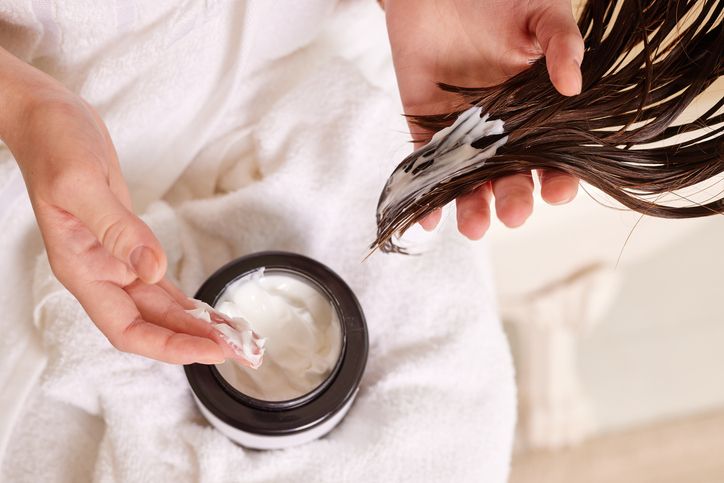
Use damp hair—not dripping wet, not completely dry
Detangling hair works best when your hair is damp. Hair that's completely dry is harder to work through, and hair that's soaking wet stretches more, which increases the chance of hair breakage. Use a spray bottle to lightly mist your hair if it’s already dry. Focus on getting it slightly damp—enough to soften hair strands without making the hair shaft too fragile.
Apply a leave-in conditioner or hair oil
Once your hair is damp, apply a leave in conditioner or a few drops of coconut oil, olive oil, or another natural oil. These help smooth the hair cuticle layer and reduce friction. Products like hair conditioner or detangling spray make it easier for tools like a wide tooth comb or detangling brush to glide through tangled hair without pulling or snapping it.
Work in sections for control
Use a rat tail comb or your fingers to separate your hair into sections. Smaller sections make it easier to manage stubborn knots, especially if you have textured hair or very long hair. This also helps you focus on each area without dragging through all the knots at once.

Use a Wide-Tooth Comb or Detangling Brush
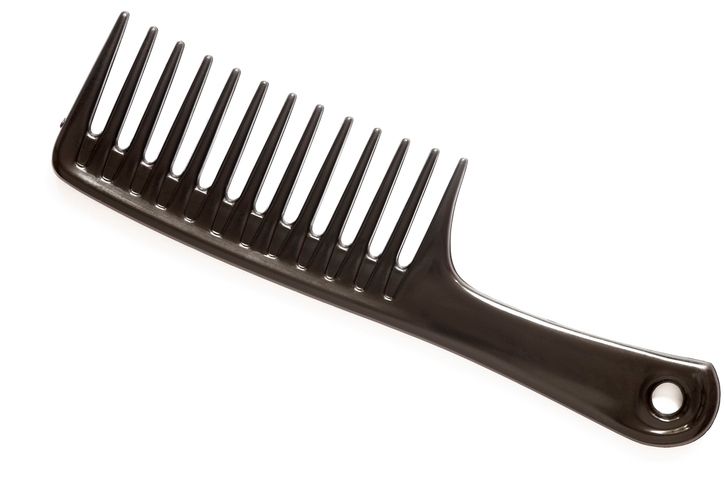
Choose the right detangling tool
After applying leave in conditioner or hair oil to damp hair, reach for a wide tooth comb or detangling brush. These tools help detangle hair gently without putting too much stress on the hair shaft. A wide-toothed comb is best for very long hair, thick hair, or knotted hair because its spacing lets it glide through tangled strands without catching or tearing them.
If you have fine hair or naturally curly hair, a flexible detangling brush might work better. These brushes are made to bend with the hair instead of against it, reducing hair breakage and helping keep the hair smooth.
Start from the bottom
Begin at the ends of your hair, where hair knots tend to form. Hold a small section of hair about two inches above the knot to avoid pulling on your scalp. Use the comb or brush to gently work through the tips before moving up. This prevents knots from bunching together into a huge knot or tangled mess.
Use light pressure and slow strokes
Gently pull through each knot using short strokes. If you feel resistance, stop and use your fingers to loosen the knot before combing again. For a big tangled knot or stubborn knots, you can add a few drops of coconut oil or spray on more detangling spray. Keep going section by section until the hair is tangle free.
Avoid fine tooth combs
Fine tooth combs can snag on hair, especially if it’s wet or already damaged. They’re more likely to cause hair breakage and damage hair follicles. Stick with tools that are gentle and made for detangling hair without harsh pulling.
Read More
Book Now to Experience
F8 Hair Regrowth Treatment
1 Minute Self-Registration
Date should not be before minimal date

Apply Leave-In Detangling Products

Prep your hair with the right product
Before you comb through tangled hair, apply a leave-in conditioner or a detangling spray. These products coat the hair shaft, reduce friction, and make it easier for your comb or brush to move through without getting stuck. They also help protect against hair breakage, especially on damp hair that’s more fragile.
Use a spray bottle if your hair has started to dry. Work with hair that’s damp but not soaking wet. This gives the product a chance to stick to the strands without making the hair too elastic.
Focus on problem areas
Spray or apply the product evenly through each section, especially where you usually get hair knots—like the nape of your neck or the ends of long hair. If you’re dealing with a big tangled knot or stubborn knots, let the product sit for a minute or two before trying to detangle.
For fine hair, choose a lightweight detangling spray that won’t weigh it down. If you have thick, textured hair or naturally curly hair, you might need a heavier cream or leave-in conditioner with natural oils like coconut oil or extra virgin olive oil.
Let the product do the work
You don’t need to rush. Once applied, the product starts breaking down knots on its own. Let it sit for a bit before using a wide toothed comb or detangling brush. This small wait can make a big difference in how easily the tool moves through your hair.

Section Hair for Better Control
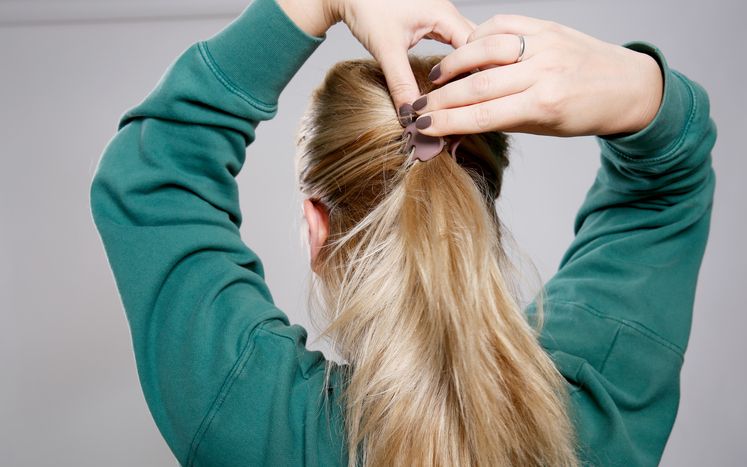
Divide and manage in smaller parts
Working through all your hair at once leads to missed knots and uneven tension. Instead, use clips or gentle hair ties to divide your hair into sections. Part your hair down the middle, then across the crown to create four even quadrants. This keeps tangled hair separate from detangled areas and gives you better control over what you’re working on.
If you have very long hair, thick hair, or textured hair, divide each quadrant into smaller subsections. The smaller the section, the easier it is to get knots out of hair without damaging it.
Keep sections secure and tidy
Secure all unused sections with a clip so they don’t get in the way or tangle with other strands. This prevents future knots while you work and lets you focus on one part at a time. If your hair is wet or damp, don’t twist the sections too tightly—this can stress the hair shaft and lead to breakage.
Start at the back and move forward
Begin with the section at the nape of your neck. These lower parts often hold hidden tangles that can grow into stubborn knots if skipped. Work from bottom to top, one section at a time, releasing each part only when the previous one is smooth and tangle free.
Using a wide toothed comb, gently comb through each section without forcing it. Keep tension low and adjust your grip as needed. This approach reduces the chance of pulling on hair follicles and damaging the cuticle layer.
Book Now to Experience
F8 Hair Regrowth Treatment
1 Minute Self-Registration
Date should not be before minimal date

Work From Bottom to Top

Start at the tips to avoid spreading knots
Trying to detangle from the roots down pushes knots tighter and spreads them into other strands. Instead, begin with the ends of your hair. These areas are where knots often form, especially in fine hair, long hair, or hair that hasn’t been trimmed in a while.
Use a wide tooth comb or detangling brush to gently comb through the tips in short, careful strokes. If you hit a tangle, apply a few drops of olive oil or coconut oil to help loosen the strands without force. This reduces stress on the hair shaft and helps prevent hair breakage.
Move up slowly in small sections
Once the tips are tangle free, move up about an inch and continue combing. Hold your hair just above where you’re working to keep tension off your scalp. This technique is helpful for all hair types, but especially important if you have damaged hair or a sensitive scalp.
Keep working your way up the hair in small steps until you reach the roots. For better control, section your hair horizontally using clips—about two inches thick per layer works well. Release one section at a time to stay organized and prevent new tangles from forming as you work.
Keep the top layers out of the way
While you’re focused on the lower layers, use clips or a hair wrap to keep the top of your hair secure. Loose strands falling into the sections you’re working on can cause a tangled mess, especially if the hair is still wet or coated with product.
This bottom-to-top method is the safest way to detangle knots without creating new ones or pulling on your scalp.

Try the Finger-Detangling Method

Use your fingers before reaching for a comb
If your hair is especially fragile, dry, or full of tight knots, start by finger-detangling. Using your hands lets you feel each knot and gently work through it without ripping through strands. This method is helpful for all hair types but especially effective for textured hair, naturally curly hair, or hair prone to split ends.
Apply a leave in conditioner or a few drops of hair oil like coconut oil or olive oil before starting. Dampen the hair slightly with a spray bottle if it’s too dry—this adds slip without making the hair overly elastic.
Work with small sections and low tension
Separate your hair into manageable parts. Hold one section in place with one hand and use the other to gently pull apart any visible knots. If you hit resistance, pause. Try loosening the knot by working around it with your fingers, rather than pulling straight through it.
This approach reduces the risk of hair breakage, especially if your hair is damaged or fine. Finger-detangling gives you more control over pressure and direction, which helps keep the hair shaft and hair follicles protected.
Combine with other tools if needed
You don’t need to stick with only your fingers. Once you’ve broken up a big tangled knot or softened a tight area, you can follow up with a wide toothed comb or detangling brush. Finger-detangling is simply a gentle first step that prevents damage while prepping the hair for more detailed work.
Book Now to Experience
F8 Hair Regrowth Treatment
1 Minute Self-Registration
Date should not be before minimal date

Use Natural Oil Treatments

Oils help loosen knots and protect the hair shaft
Natural oils reduce friction between tangled hair strands, making it easier to get knots out of hair without breaking it. They also coat and protect the cuticle layer, which helps prevent hair damage during the detangling process.
Coconut oil is especially effective—it penetrates the hair shaft and helps soften tight knots. Olive oil and argan oil are great options for dry hair or knotted hair that hasn’t been treated in quite a while. These oils add slip, making the detangling process smoother and less stressful on the hair.
How to apply oils for detangling
Start with damp hair. Apply a few drops of your chosen oil directly to the tangled areas or over the entire section if needed. Use your fingers to gently distribute the oil from mid-length to ends. For thick or very long hair, you might need a bit more to fully coat the strands.
If you’re working with a big tangled knot or severely matted hair, let the oil sit for 15–30 minutes. This allows the hair to soften and absorb the oil. Cover your hair with a cotton t shirt or hair wrap while waiting to prevent mess and help retain moisture.
Best oils for different hair types
• Coconut oil: Ideal for deep hydration and reducing protein loss
• Olive oil: Moisturizes dry hair and softens stiff knots
• Argan oil: Adds shine and protects from heat and friction
• Jojoba oil: Balances scalp oils and reduces buildup
• Almond oil: Helps strengthen fine hair and prevent split ends
Natural oil treatments are especially useful if you detangle your hair regularly or if your hair type is prone to dryness and tangling.

Sleep on Silk or Satin Pillowcases
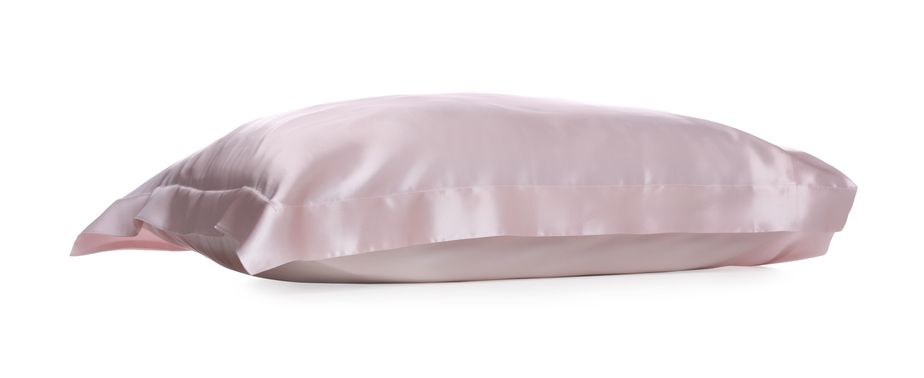
Reduce friction while you sleep
Most hair damage and tangling happens overnight—especially if you toss and turn or sleep on a cotton pillowcase. Cotton pulls at hair strands, absorbs natural oils, and creates friction that can form knots by morning. Switching to a silk pillowcase or satin pillowcase helps your hair glide smoothly across the surface, reducing friction and keeping hair smooth.
This small change is especially helpful for long hair, fine hair, or naturally curly hair, which are more prone to forming stubborn knots during sleep.
Keep moisture and prevent future knots
Silk and satin fabrics don’t soak up your hair’s oils like cotton does. This helps keep your strands hydrated, reducing dryness and hair breakage. Less dryness means fewer split ends, fewer tangles, and healthier hair overall. For added protection, you can also wrap your hair in a silk scarf or wear a silk bonnet.
If you’re using hair oil or a leave-in product before bed, sleeping on silk helps lock in that moisture, letting the product work overnight without drying out.
Combine with loose protective styles
To prevent all the knots from forming while you sleep, gently comb your hair before bed and secure it in a loose braid or bun. This keeps hair strands from twisting around each other. Use a wide toothed comb or your fingers to remove any tangles before tying your hair up.
This simple routine—combined with silk or satin—helps keep your hair tangle free by morning and reduces the amount of detangling needed day to day.
Book Now to Experience
F8 Hair Regrowth Treatment
1 Minute Self-Registration
Date should not be before minimal date

Protect Hair While Swimming

Prevent knots before they form
Swimming—whether in a pool or the ocean—can leave your hair in a tangled mess. Chlorine, salt water, and constant movement cause the cuticle layer to lift, making it easy for hair strands to catch and knot. If you swim often, you’ll need to protect your hair before getting into the water to avoid stubborn knots and long detangling sessions afterward.
Create a barrier before you swim
Start by wetting your hair completely with clean water. Hair wet with fresh water absorbs fewer harsh chemicals from pool or sea water. Then apply a leave in conditioner or a few drops of coconut oil or olive oil. These create a slippery layer over the hair shaft, making it harder for water and debris to stick.
Once coated, gently comb your hair with a wide tooth comb to spread the product evenly. Then tie your hair in a braid or secure it in a bun to reduce tangling while you swim.
Use a swim cap and rinse immediately
Wearing a snug swim cap helps keep your hair dry and reduces contact with water. Make sure all your hair, including baby hairs around the edges, is tucked in. After swimming, rinse your hair right away with clean water. Then follow up with a gentle shampoo to remove chlorine or salt and apply a deep conditioner or hair mask to restore moisture.
Protecting your hair while swimming helps prevent future knots and keeps your hair healthier and easier to manage.

Regular Trims and Maintenance
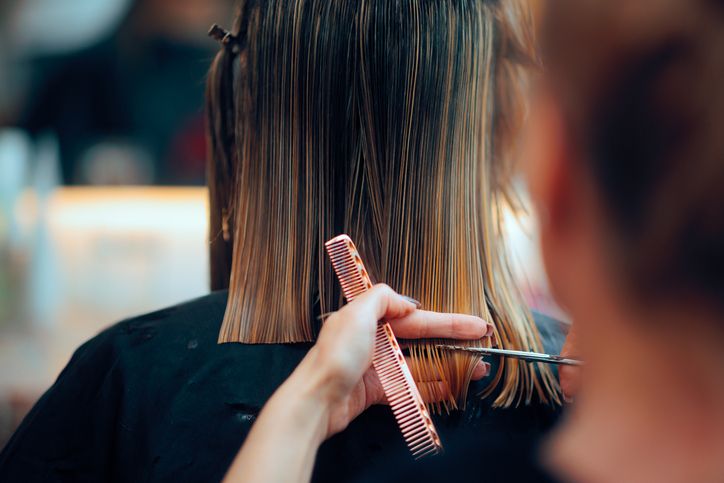
Trim hair regularly to prevent knots
Split ends and damaged hair don’t just look rough—they tangle more easily. As split ends move up the hair shaft, they catch on other strands and form knots. Getting your hair trimmed every 8 to 12 weeks helps stop this from happening. Removing dead hair keeps the ends clean and smooth, which makes detangling easier and helps prevent future knots.
If your hair type is prone to dryness or you use heat often, more frequent trims may help reduce stubborn knots.
Keep a routine that supports tangle-free hair
Between trims, take care of your hair daily. After washing, use a leave in conditioner and gently comb through your hair while it's still damp. Focus on the ends first, and work your way up with a wide tooth comb or detangling brush.
Use a deep conditioner or hair mask once a week to keep hair hydrated. Avoid sleeping with loose, dry hair—secure it in a braid, bun, or wrap it in a silk scarf. If your hair is very long or prone to tangling overnight, sleep on a silk pillowcase and lightly oil the ends before bed.
Stay consistent
Keeping your hair smooth and manageable is about regular care, not one-time fixes. Using the right tools, gentle products, and trimming your hair regularly will help reduce the number of knots and make it easier to detangle your hair every time.

Boost Your Hair Health with F8 Hair Regrowth Treatment
Stronger hair strands make detangling easier
If your hair breaks easily or forms knots no matter how gentle your detangling routine is, your hair strands may be weak at the root. Brittle, thinning, or damaged hair tangles more often and is harder to manage—even with proper tools and products.
That’s where F8 Hair Regrowth Treatment comes in. This non-invasive laser-based treatment supports the foundation of healthy hair by improving scalp condition and strengthening hair follicles. With stronger strands and a healthier scalp, your hair becomes more resistant to damage and far less prone to forming tangles or split ends.
How F8 works
F8 Hair Regrowth Treatment uses low-energy laser beams to gently stimulate the scalp. The laser energy penetrates the skin to:
• Improve blood flow and scalp microcirculation
• Revive weak or inactive hair follicles
• Strengthen the papilla and capillaries that nourish your hair
This not only promotes new hair growth but also improves the texture and strength of existing strands. After each session, a hydrating serum is applied to balance the scalp’s oil levels and reduce excess sebum—another common cause of knotting and dull, heavy hair.
Why F8 helps reduce knots and breakage
Healthier hair strands hold their shape better and are more flexible, which means they’re less likely to snap or tie themselves into a big tangled knot. With improved scalp function, your hair grows out with a stronger cuticle layer, making it easier to detangle your hair and maintain it between washes.
Unlike some hair loss treatments that rely on harsh chemicals or surgery, F8 is painless, comfortable, and suitable for most people. There’s no recovery time needed, and it can be done alongside your current hair care routine, including the use of topical hair oil, detangling spray, or conditioner.
Add F8 to your routine
If you deal with constant knots, thinning, or brittle strands that make brushing a daily struggle, F8 can help you go beyond surface-level solutions. By repairing the root cause—weak follicles and poor scalp circulation—you’ll support long-term hair smoothness and reduce the time you spend fighting stubborn knots.
Book F8 today and give your scalp the care it needs—so your hair can grow strong, smooth, and tangle-free.
New Beauty's F8 Hair Regrowth TreatmentBook Now to Experience
F8 Hair Regrowth Treatment
1 Minute Self-Registration
Date should not be before minimal date
FAQ
Can Tight Braids Cause Permanent Damage to Knotted Hair?
While tight braids can help manage unruly hair, they're also capable of causing permanent damage to your knotted strands through tension and friction. You'll notice that your hair can suffer from breakage, split ends, and even traction alopecia, a condition where continuous pulling leads to hair loss. If you're experiencing severe tangles, it's better to gently detangle your hair before attempting tight braiding styles.
How Long Should I Wait Before Detangling Extremely Matted Hair?
You shouldn't wait to address extremely matted hair, as prolonged neglect can worsen tangles and lead to breakage. Begin detangling as soon as you notice severe matting, but take time to properly prepare your hair first by applying a generous amount of conditioner or detangling product, letting it sit for 15-20 minutes to soften the tangles. If the matting is severe, you'll need to work slowly and methodically to prevent damage.
What Medications or Health Conditions Can Make Hair More Prone to Tangling?
Several medications and health conditions can make your hair more susceptible to tangling, including chemotherapy drugs, thyroid disorders, and medications that cause hair dryness. Nutritional deficiencies, particularly in vitamins A, B, and E, can weaken your hair structure, while hormonal imbalances from conditions like PCOS or menopause can alter hair texture. Autoimmune disorders, such as lupus, often affect hair health, and certain anticonvulsants or blood pressure medications may increase brittleness and tangling.
Are Certain Hair Types More Susceptible to Knots and Tangles?
Curly, coarse, and chemically-treated hair tends to tangle more frequently due to its texture and structure. Your hair's natural pattern, particularly if it's fine or highly textured, can create more opportunities for strands to interlock and form knots. Additionally, if you've got long hair, you'll notice increased tangling since there's more surface area for friction and wind exposure, while damaged or dry hair is especially susceptible to matting.
Should I Cut Out Severe Knots if Regular Detangling Methods Don't Work?
While cutting out severe knots should be your last resort, it's sometimes necessary to prevent further damage to your hair. Before reaching for scissors, you'll want to try intensive conditioning treatments, detangling sprays, and patient finger-combing. If you must cut the knot, isolate the tangled section carefully, and make small, precise cuts into the knot rather than cutting straight across your hair.
Recommended Articles
COPYRIGHT© NEW BEAUTY MANAGEMENT LIMITED 2025. ALL RIGHT RESERVED.




